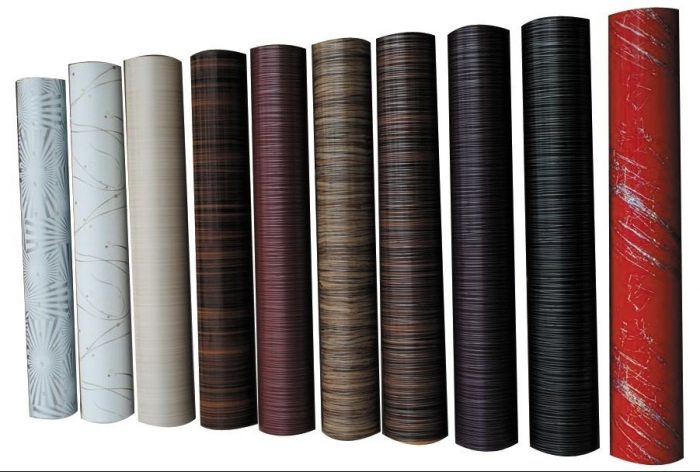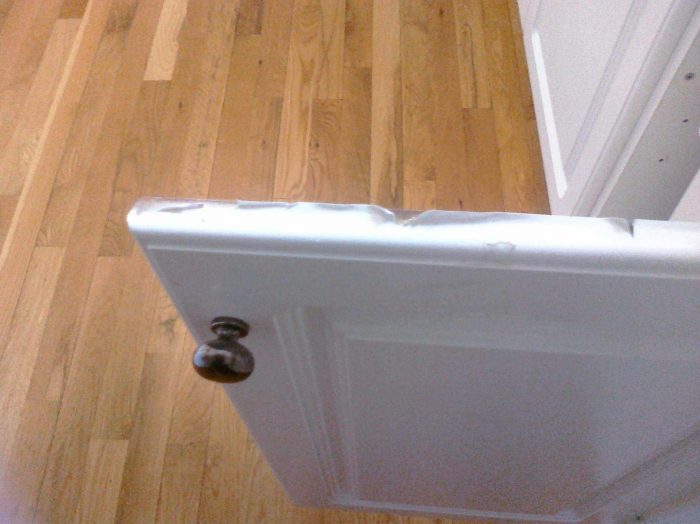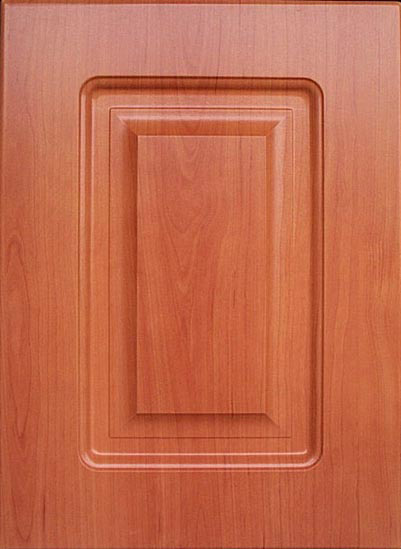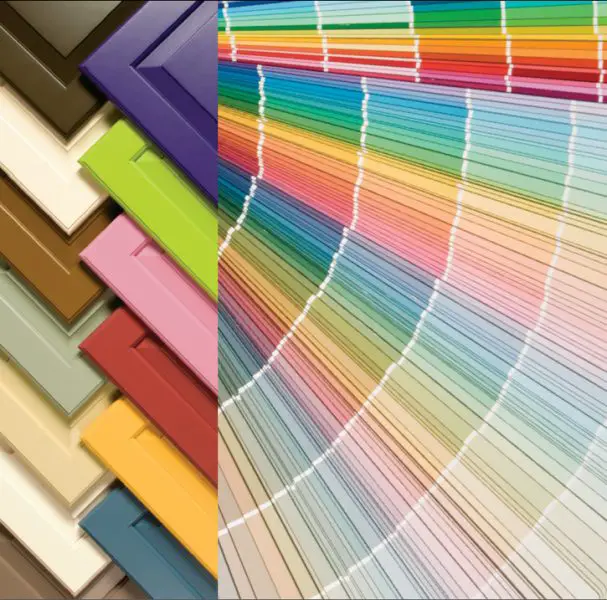MDF is a wood-derived product and although it's not the solid wood we all love, it deserves our attention too. Painted or veneered MDF furniture is beautiful, stable and good quality. An economical alternative to these variants is veneered MDF furniture, which is also very much on the market and preferred by many for its low price and wood-like designs. I will try to draw a parallel between these two variants of MDF coating, showing the pluses and minuses of each.
MDF with veneer is, as the name implies, a sheet of MDF in various shapes, over which a PVC film is laid. The foil is glued to the board with special adhesives at high temperatures using membrane presses. The press is able to follow the contours of the piece and the film can also be applied to profiled MDF. PVC film is thicker or thinner, matt or glossy. It can be colored, it can have geometric or abstract patterns, it can reproduce the wood's design, and it can also be 3D (reproducing the pores and grain of the wood). What a veneer press sold by WoodMatic looks like, you can see here.

The advantages of using veneered MDF are:
- low price
- wide variety of finishes
Disadvantages:
- lower resistance in high humidity or high temperature environments
- there may be problems with the film peeling on the edges and corners of the panel

- small air bubbles may appear between the foil and MDF
- if the film gets scratched or damaged, it cannot be repaired
- patterns that imitate wood fail to transmit the natural warmth of wood

Painted MDF is obtained by applying coats of primer and colored enamel to the surface of the processed panels. Painting is done in such a way that the entire board is well covered. Apply 1-2 coats of primer, which are sanded after drying to obtain a good surface for the colored enamel.
The top coat, the enamel, can be matte or glossy, stained in a multitude of colors. Special effects, patinas or other finishes can also be applied to increase the value of the furniture. Sometimes 1-2 coats of high-gloss clear varnish can be applied to gloss finishes to better protect the color, for depth and shine.

The advantages of painted MDF furniture include:
- much better moisture protection of the entire panel surface
- much better resistance to high temperatures
- any scratches in the film can be repaired
- using colored primers and patinas can give an antique-looking finish, very similar to painted wood
The disadvantages are:
- higher price
- longer time to the finished product
- the natural wood design cannot be reproduced. To be more precise, it cannot be easily reproduced, because there are special templates that imitate the wood's design and can be used on paint.
In addition to the advantages outlined above, painted MDF can also be considered a more nature-friendly alternative. It can also be coated with water-soluble products, which is a growing trend these days, without reducing the range of colors or finishes.
The materials used for painting - polyurethane, waterborne, UV-curable - are products that make furniture much more resistant to moisture in the kitchen or bathroom and are highly resistant to high temperatures, eliminating the risk of the film cracking when the furniture is near a heat source (hob, stove, oven).

Painted MDF furniture manufacturers can also use finishing machines or finishing lines for finishing wood not only MDF. We know that the market is constantly changing and having more versatile finishing possibilities that can be quickly adapted to market requirements is a real advantage.
Painted MDF offers the possibility of a wide variety of finishes. We have already told you about my MDF kitchenwhich I did myself. In the case of foil, you're limited to the existing pattern. Indeed, there are lots of patterns, but you have to have those foils, and I doubt that one manufacturer chooses to have hundreds of foil patterns. With paints you can play around and get a lot of finishes using a white primer, a few colors and 2-3 patinas.
Choosing painted MDF furniture offers some advantages that can sometimes outweigh the price difference. And the existence of finishing machines allows manufacturers to adapt much more quickly to demand. Staying with the possibility of applying foil to MDF at a time when trends, market requirements and the times are constantly and rapidly changing is a rather risky choice.
In addition, you may also consider coating MDF with powder paints which comes with a number of benefits that will make the finishing system far superior to existing ones.


































Hello,
I was convinced that moulded MDF was the best, so I was told, it is obvious that I was wrong, now I can only pray that my custom-made kitchen with moulded MDF fronts will last me as long as possible and that I won't end up in a situation where I get hand-painted MDF from moulded MDF. I was told that only the fronts are moulded because of the high cost. After all moulded MDF is not so good for the kitchen, where it is hot, steamy, damp. Thanks a lot for the info, from now on I'll take a better look at MDF furniture and maybe for what I need in the kitchen I'll choose painted wood cabinets or shelves... Have a nice day!
Hello, if I may, I would like to add an advantage to painted MDF: the finishing films obtained from film-forming materials (varnish, paint, enamel, primer) considerably reduce the emission of formaldehyde from MDF, due to its structure (it consists of several layers). Each layer applied subsequently reduces the porosity of the previous layer by 50 %.
Thank you. A very welcome and important addition.
Hello,
Thank you for this very well put together article in which you have detailed the differences between the 2 types of finishes as well as you could. You have just simplified the presentation process for us as well.
I would like to know if I can apply two-component polyurethane varnish over a paint for gloss.
It depends on the nature of the paint. If you want to apply over two-component polyurethane paint or water-based paint, you can, but you have to sand beforehand so that the varnish has adhesion. Sanding is done on the day of application. It cannot be applied over nitro or alkyd paint (based on linseed oil and petroleum solvents).
If the foil has peeled off in places and curled in areas exposed to heat can it be glued and with what?
If not, can the foil be peeled off and the MDF reused for relaminating or painting?
Thanks in advance!
Hello.
If the foil is thermoplastic you can also glue it by ironing with an iron (put a cloth or a blanket on the foil, so that only heat reaches the foil). You can use polyurethane or hot melt adhesives because they don't react instantly and this gives you time to do a good job (about these adhesives, but also others that can be used in DIY projects, find information in the link below). You need to stretch the foil well and remove the air between it and the MDF board.
If the foil has come loose in places it can be peeled off the entire surface. When you pull it off, try heating the contact area between the foil and the board with a hair dryer. The MDF is sanded after the foil has been removed and can be re-sanded (if there is a press) or painted. Polyurethane paints are recommended because they are resistant.
All the best!
https://revistadinlemn.ro/2018/07/17/5-tipuri-de-adezivi-pentru-proiecte-de-bricolaj/
Don't forget to subscribe to the printed Wood Magazine! For only 58 lei/year you can find out news in the field, discover craft ideas or trade secrets. We remind you that the content in the printed magazine is different from the one on the website. Details in the link below.
Thank you!https://revistadinlemn.ro/product/abonament-revista-din-lemn/
Hello Mrs Mihaela.
Can you point out a very glossy varnish to be applied to the pale casing, I mean the inside as it would be much easier to maintain and easier to sanitize with hot water and soap, frequently with sanitary alcohol specifically? I myself don't like commercially available mixed cleaning products, so I'm going with the doctor's recommendation using the two shown above. I'm also thinking about the inside of all the drawers in a house exposed to street dust by locating the building close to the street, anything you do gathers and as it annihilates it the scented soap doesn't annihilate anything. But I've worn myself out scrubbing the inside of drawers with soap and rinsing them afterwards, so I'd prefer to switch strictly to rubbing alcohol, quickly, once a month. Then reading what Mrs Liudmila wrote about emissions, I'm thinking that we still don't know what kind of furniture materials would and wouldn't emit harmful emissions to us, so it occurs to me that maybe a slightly thinner varnish could be applied with the help of - by chance I got on the net - a famous little electric paint sprayer that has an adjustable nozzle, i.e. it could be gradually turned off/adjusted. Now, I'm thinking with regret about the melacard furniture that could be easily sanitized. Where did it disappear to? It seems that even 71 euro/sqm for infill can still be money wasted in the kitchen, I think that for the casing it would cost a lot more to apply lacquer in the factory, then no one deals with the inside of the drawers in the furniture previously purchased by someone, they all deal with what they want to sell now.
I would thank you from the bottom of my heart for this information.
Let's be healthy.
Hello.
The most alcohol-resistant varnishes are those with hardening (polyurethane, acrylic, polyester varnishes, etc.). What I don't understand is why you want it to be glossy since you are using it indoors? Gloss is picky and over time will not look good.
Lacquers without high chemical resistance (nitrocellulose) will fade from alcohol (lose gloss and transparency).
The problem with lacquering can be lack of adhesion. If the furniture is made of glossy melamine chipboard or with a very smooth surface it is difficult to apply varnish because it does not stick to the backing. To increase adhesion, the surface should be sanded which spoils the appearance.
I think you can do it much more simply. The melamine surfaces of chipboard are alcohol resistant, so you don't need lacquer to sanitise the insides of drawers. In my opinion, lacquering more will complicate it.
And I recommend washing furniture with soap and water or water and dishwashing detergent. It's the most effective and easiest way to degrease it. Regardless of how the furniture is finished. The important thing is that the washing is done with a squeezed cloth or sponge and at the end it is well wiped and wiped.
For more information on emissions from wood chips (formaldehyde) or finishing products (VOCs - volatile organic compounds), see the links below.
All the best!
https://revistadinlemn.ro/2017/10/30/emisia-de-formaldehida-placilor-derivate-din-lemn-un-subiect-mereu-fierbinte/
https://revistadinlemn.ro/2018/11/09/ce-inseamna-cov-de-pe-eticheta-lacurilor-si-vopselelor-si-cum-ne-afecteaza-emisia-lor/
Thank you kindly for your kindness in replying.
You see, I don't know chemistry like the specialists.
In the past my father had a wardrobe that was lacquered and could be washed quickly and easily without being affected by soapy water. I washed it for decades without the appearance being distorted in any way. We've even been flooded by neighbors and it stayed ok. What kind of varnish would it have been that there was a restricted palette in those years, the kind that didn't stand up to the water so you could see the splashes and the kind that held up! I doubt that that waterproof varnish would have needed UV to dry, or the technology needed for the MDF variant that someone specified would be extremely expensive. But today I don't know of anything so durable being made on a large scale and not even used for interior finishing if it's used at all on the outside, but I'm not as informationally savvy as you are! E, it's a nostalgia of mine. Towards something like that I would tend towards a little Bonanta bookcase with a very successful exterior, which I have become emotionally attached to but which has drawers with a plywood (I think they call it pfl)whose surface takes over time, and reacts to water, tends to swell, leaves the color and becomes somewhat dusty and if you rub it a little with soap, especially when you take it with a damp rag. Unfortunately it wasn't the series for export where it didn't leave the quality to be desired, it was just after the `90s when they were getting spicy with everything through the interior and demand correction, support. There I would like to understand what varnish I could apply that would be waterproof. You have offered multiple choices which have me bewildered. I specified that I prefer gloss, but of all of them, which can it be? I would like you to specify exactly if you know so much, then I would know it's ok and I would trust it. When you have time, it's not urgent, I would do it around summer. I will also answer your question about the fact that I would like to have shiny varnish in the pale lacquer casing because it is deep, I see worse on matte in the depth of the casing and in semi darkness; I may be the perfectionist scale, but I don't have a lighting system inside that turns on when I open the door (maybe I can give ideas for a deal! I have another housewife, my father who, when you don't see him, intervenes inopportune and uninvited and I can't do anything to him, I discover after the "intervention" that there's chocolate cream or something else there and he doesn't remember what he did on the intention that later he will eat what he put there, but that's how it is with them from a certain age and in addition I LIKE to shine, it gives a feeling of freshness, of real cleanliness which gives me comfort inside and I like to rinse with plenty of water, very fast, you can directly under the faucet jet the drawers, the removable countertops, how easy to clean without them inside and it goes fast and comes out correctly. Then I don't like to scrub to rinse, I have the feeling that it's still not ok 100%, that it's still partial rinsing, why keep scrubbing and changing sponge, cloth, bleah, when I can go directly under the jet what can be there fast as not to affect, and if it's varnish that isolate water / moisture is perfect! I washed in my youth and the windows put in the tub to be on all sides well scrubbed under the shower jet and soaped and showered, today it doesn't work like that anymore. And it was really fast and really clean. The clean smell was my reward. But back then I only had 3 windows, today I have too many and the new kind doesn't allow it, but it doesn't require as much effort as the wooden ones, nor do you risk hurting your fingers as with the wooden ones if you do it fast. What can you do, the scales are typical, I also think that I don't have the patience to imitate the rinsing on dry, it gives me the feeling of an anus against nature, I prefer directly under the jet, the water flows strongly and takes everything, you scrub with the rinsing brush f. fast and it stays perfect and it goes fast and you're done fast much of the house and you get the maximum, you're heading towards hygiene. And thank you once again for indicating what I would need, that's me, that's how I am, that's how I got used to, I like to spend my time as I like, I give myself time in abundance, I do not waste it on drawers, it must go fast, others go to the cosmos, dear lady, we to the clatit with carp which also require cleaning then or with sponges inside furniture? With my unreserved esteem.
The varnish you refer to is polyester. It is very durable and glossy, but impossible to apply at home. To apply the varnish you need to mix it with accelerator and catalyst. If these two products come into contact, it explodes. In the factory, half the quantity of varnish is mixed with accelerator and half with catalyst and then put together. In the past, they used to make those shiny cabinets with a thick layer of varnish.
For the inside of the drawers use gloss varnish with hardener (polyurethane or water-based). Ask in specialist or DIY stores.
All the best!
Hello,
I read the article and understand that painted mdf is better quality for kitchen furniture.
Can you tell me if there is a major difference between 18mm thick painted mdf and 22mm thick painted mdf?
Thank you,
Oana
Hello,
The difference is thickness and weight. If we are talking about the bulkheads, the 22 is stronger than the 18.
There is no difference between the two categories of mdf in the case of painting.
All the best!
Hello, but how do you know all this? Infilled MDF does not peel if it has the right amount of adhesive. Have you told your customers what happens if they hit a painted door in the corner? Shall I tell you? The paint jumps... Do you know why moulded MDF is not better? Because an MDF paint gun costs 2-3000 lei while a moulding press costs tens of thousands of euros...That's why grapes are sour...When you can't have something you sling mud...
Dan, do you recommend moulded MDF for bathrooms?
As you can see, there are opinions and opinions! What should we think now? Anyway, the prices are not modest today for most of my dear compatriots who cannot afford mdf but e-mag kitchens. But now, we'll think about framing the edges in metal frames that will soon offer satin/printed/antiqued versions and thus we'll create a new way to win customers, we'll launch a novelty on the world market and, we'll have billions in our accounts! We will make a common frame structure with the hinges and come out with something new presented as recommended to the discerning because it gives resistance over time.
I, first of all, thank the lady who writes here for the helpful education she offers us laymen.
Then thanks to those who have different opinions.
Good health and good days.
Hello, moulded MDF is much more scratch resistant.We have had moulded MDF in our kitchen for about 10 years and it looks impeccable.Plus as long as you can achieve the same colour from both methods, moulded or painted, painted MDF does not justify the price.
Hello,
I would like to know according to what criteria the thickness of the pvc film used for the mdf is determined and what is the difference in quality between rigid and flexible pvc film.
Sincerely,
Hello! I also have a big dilemma. I'm about to make a new kitchen furniture, new house and I don't know what to choose. I have already talked to 3 people who execute furniture and the opinions were different. Please tell me what to make it out of, as I cook quite a lot. Mdf moulded, mdf painted, glossy or melamine palate. which will resist more to steam, heat, humidity?
Please give me ub advice. Thank you. Health
Hello!
From my point of view painted MDF is the best. I have kitchen furniture with doors made of MDF painted with polyurethane varnish, the frame is made of melamine chipboard. It's been made for 20 years and holds up very well, despite the fact that I cook quite a bit myself. You have below a link to an article where I talk about this kitchen (there are photos too). I don't recommend making it shiny though because it takes a lot of maintenance. For my kitchen I used a 30 gloss lacquer and it looks great.
I wish you good health too!
https://revistadinlemn.ro/2016/07/06/bucataria-mea-antichizata-din-mdf/
Hello. in case of exfoliation, can't the skin be re-exfoliated? do the fronts have to be completely redone? esteem
Hello!
Theoretically, it is possible. To re-folder, the surface of the MDF must be thoroughly cleaned of the old layer of adhesive, sanded and stripped so that the foil sits well and no defects appear. It's a lot of work and you'd be hard pressed to find someone to do it. Most prefer to do the door from scratch.
Hello,
Thanks for the article. I'm working on converting a self-driving van (I've also contacted you on tung oil and thanks again for the replies). I've made some furniture doors out of painted plywood but they are not very straight in plan, which is why I switched to mdf doors. Being much heavier, I just made a frame of about 8cm and inside I will put something else, never mind that now. I need to paint them. So far, on the plywood I used hornbach matt white polyurethane paint, single component primer before, there is also primer of the same brand, I find it ok and would still go for it. The question is on the prep side. I've heard of the simpler and better option of spritching (or simple grouting) to close the pores, then fine sanding and painting. What do you think?
Thank you.
Hello!
This type of putty, also called pore filler putty, is used more on wood or where there is high absorption (in the case of poor quality, loose MDF). If the MDF is of good quality, there is no need for putty. Primer, applied in 2 coats, sanded and then paint applied is sufficient. I don't see the point of putty, especially if you say you are happy with the look of the finish on the plywood.
If you still use putty, it is very important that the next coat adheres to it. If it doesn't adhere well, there is a risk that the paint will peel off when mechanical shocks or shaking occur.
Thanks. I went the primer route. I gave it a coat today and by the way the fibers have lifted a bit, I think I chose the right option. I was afraid I'd have a "hedgehog" that would be hard to smooth out.
I would like to ask you one more question. The doors, both the two back doors and the sliding door, have some kind of glossy pfl boards on the bottom half, I think melamine. Unfortunately it's a bit scratched because the van, although quite new, has been working for me, but it's been carrying goods. I'd like to paint them too but I don't know which paint is more suitable and how to prepare the backing, or if you think it's more ok to roll them, especially as they only have one side visible, but I'm a bit afraid of rolling the back doors, inevitably when I walk around with them open, I might touch them with some objects.
Incidentally, I recently needed some more 4mm plywood and next to me they only had beech. Hard and strong, that I liked, but heavy, luckily I didn't need much (on the whole van I used alder, ff light but also ff veneer). What I want to say as a curiosity. When cutting with the circular saw it got blackened by the burn, I didn't care because I couldn't see it, but I had some milling slats on the edges of the half-round and it burned there too, even at slower speeds, and the worst thing is that the burn is deep, I took 2-3 mm more and I still didn't get rid of it. It was still laced and would have shown. I gave up on beech and made it out of some alder scraps, no problem. I couldn't quite figure out why it burns, maybe it lights up easier....
Thank you once again.
There is a special primer/insulator that is applied to melamine to increase the adhesion of the paint. I don't know if you can find it in DIY stores, but you can certainly find it at those who sell professional wood paints (Sirca, Sayerlack-Golda, ICA-Lomilux, Renner, Remmers, Milesi, etc). Apply a stain after which you can apply the paint you have already used. After drying, the primer is sanded so that the paint has adhesion.
Beech is a very good firewood. It ignites easily, burns well and gives off a lot of heat. In this case, the circular saw blade was too fast or not sharp enough and thus overheated, burning the beech wood.
Thank you very much!
All esteem!